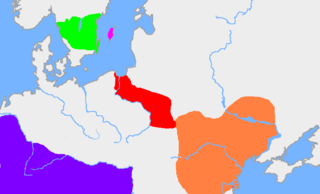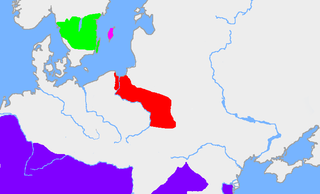Related Research Articles

The Goths were a Germanic people who played a major role in the fall of the Western Roman Empire and the emergence of medieval Europe.

Jordanes, also written as Jordanis or Jornandes, was a 6th-century Eastern Roman bureaucrat widely believed to be of Gothic descent who became a historian later in life. Late in life he wrote two works, one on Roman history (Romana) and the other on the Goths (Getica). The latter, along with Isidore of Seville's Historia Gothorum, is one of only two extant ancient works dealing with the early history of the Goths.

The Rugii, Rogi or Rugians, were a Roman-era Germanic people. They were first clearly recorded by Tacitus, in his Germania who called them the Rugii, and located them near the south shore of the Baltic Sea. Some centuries later, they were considered one of the "Gothic" or "Scythian" peoples who were located in the Middle Danube region. Like several other Gothic peoples there, they possibly arrived in the area as allies of Attila until his death in 453. They settled in what is now Lower Austria after the defeat of the Huns at Nedao in 454.

The Gepids, were an East Germanic tribe who lived in the area of modern Romania, Hungary and Serbia, roughly between the Tisza, Sava and Carpathian Mountains. They were said to share the religion and language of the Goths and Vandals.

The Swedes (probably from the PIE reflexive pronominal root *s e, "one's own [tribesmen/kinsmen]"; Old English: Swēon) were a North Germanic tribe who inhabited Svealand in central Sweden and one of the progenitor groups of modern Swedes, along with Geats and Gutes. They had their tribal centre in Gamla Uppsala.

De origine actibusque Getarum, commonly abbreviated Getica, written in Late Latin by Jordanes in or shortly after 551 AD, claims to be a summary of a voluminous account by Cassiodorus of the origin and history of the Gothic people, which is now lost. However, the extent to which Jordanes actually used the work of Cassiodorus is unknown. It is significant as the only remaining contemporaneous resource that gives an extended account of the origin and history of the Goths, although to what extent it should be considered history or origin mythology is a matter of dispute.

Ermanaric was a Greuthungian Gothic king who before the Hunnic invasion evidently ruled a sizable portion of Oium, the part of Scythia inhabited by the Goths at the time. He is mentioned in two Roman sources: the contemporary writings of Ammianus Marcellinus, and in Getica by the sixth-century historian Jordanes. He also appears in a fictionalized form in later Germanic heroic legends.
The Vistula Veneti were an Indo-European people that inhabited the region of central Europe east of the Vistula River and the areas around the Bay of Gdańsk. The name first appeared in the 1st century AD in the writings of ancient Romans who differentiated a group of peoples whose manner and language differed from that of the Germanic and Sarmatian tribes. In the 6th century AD, Byzantine sources described the Veneti as the ancestors of the Slavs, who during the second phase of the Migration Period moved south across the northern frontier of the Byzantine Empire.

Scandza was described as a "great island" by Gothic-Byzantine historian Jordanes in his work Getica. The island was located in the Arctic regions of the sea that surrounded the world. The location is usually identified with Scandinavia.

Oium was a name for Scythia, or a fertile part of it, roughly in modern Ukraine, where the Goths, under a legendary King Filimer, settled after leaving Gothiscandza, according to the Getica by Jordanes, written around 551.

Berig is a legendary king of the Goths appearing in the Getica by Jordanes. According to Jordanes, Berig led his people on three ships from Scandza (Scandinavia) to Gothiscandza. They settled and then attacked the Rugians who lived on the shore and drove them away from their homes, subsequently winning a battle against the Vandals.
The Charudes or Harudes were a Germanic group first mentioned by Julius Caesar as one of the tribes who had followed Ariovistus across the Rhine. While Tacitus' Germania makes no mention of them, Ptolemy's Geographia locates the Charudes (Χαροῦδες) on the east coast of the Cimbrian peninsula.
The Amali – also called Amals, Amalings or Amalungs – were a leading dynasty of the Goths, a Germanic people who confronted the Roman Empire during the decline of the Western Roman Empire. They eventually became the royal house of the Ostrogoths and founded the Ostrogothic Kingdom of Italy.
The Gutones were a Germanic people who were reported by Roman era writers in the 1st and 2nd centuries to have lived in what is now Poland. The most accurate description of their location, by the geographer Ptolemy, placed them east of the Vistula river.
Ardaric was the king of the Gepids, a Germanic tribe closely related to the Goths. He was "famed for his loyalty and wisdom," one of the most trusted adherents of Attila the Hun, who "prized him above all the other chieftains." Ardaric is first mentioned by Jordanes as Attila's most prized vassal at the Battle of the Catalaunian Plains (451):
Peter John Heather is a British historian of late antiquity and the Early Middle Ages. Heather is Chair of the Medieval History Department and Professor of Medieval History at King's College London. He specialises in the fall of the Western Roman Empire and the Goths, on which he for decades has been considered the world's leading authority.
The Vidivarii are described by Jordanes in his Getica as a melting pot of tribes who in the mid-6th century lived at the lower Vistula:
Ad litus oceani, ubi tribus faucibus fluenta Vistulae fluminibus ebibuntur, Vidivarii resident ex diversis nationibus aggregati.

Theodoric I was the King of the Visigoths from 418 to 451. Theodoric is famous for his part in stopping Attila at the Battle of the Catalaunian Plains in 451, where he was killed.
Boz was the king of the Antes, an early Slavic people that lived in parts of present-day Ukraine. His story is mentioned by Jordanes in the Getica (550–551); in the preceding years, the Ostrogoths under Ermanaric had conquered a large number of tribes in Central Europe, including the Antes. Some years after the Ostrogothic defeat by the invading Huns, a king named Vinitharius, Ermanaric's great-nephew, marched against the Antes of Boz and defeated them. Vinitharius condemned Boz, his sons, and seventy of his nobles, to crucifixion, in order to terrorize the Antes. These conflicts constitute the only pre-6th century contacts between Germanics and Slavs documented in written sources.
Vadamerca or Valadamarca may have been a Gothic princess and Goth royal family member by birth, and consort of the Rex Hunnorum Balamber, possibly the first ruler of the Huns. The only extant source that mentions her or Balamber is Jordanes' Getica, and it is possible that both are unhistorical.